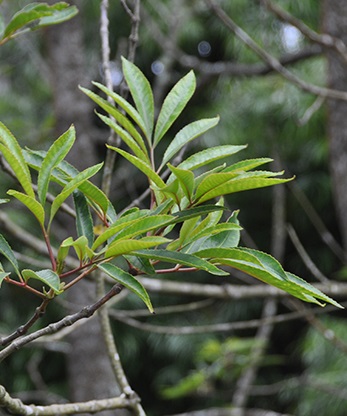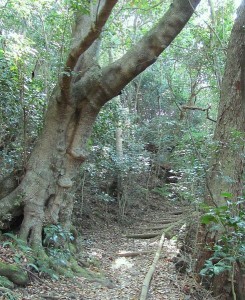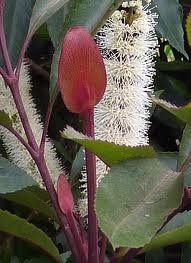Red Alder – Cunonia capensis
(Rooiels)
Red Alder occurs throughout the mountain forests from the Cape Peninsula to Natal and Eastern Transvaal.
This tree is particularly common in the Southern Cape as an evergreen tree of up to 18m tall, or even taller under ideal conditions. The crowns of the larger trees are relatively sparse.
The bark is pale and flaky, becoming dark greyish-brown, rough and fissured. The young stems are pinkish red. The stem is straight and round. There can be small round pustules (cork patches) on the bark, resembling ostrich skin.
The leathery, dark green, opposite leaves have 3-5 opposite pairs of leaftlets and one end leaflet. The round leaf stalks are red or reddish, and the margins are sharply toothed.
The small, creamy, sweet-scented flowers occur in long, dense, spike-like racemes. When in flower, these erect, paired racemes look like candles, which make it easy to identify this tree. March – May.
The fruit is a small, dark brown, leathery capsule of about 10mm long, tipped with horn-like styles. It contains numerous small, yellowish seeds. April – July.
The tiny seeds do not germinate well in cultivation, but seedlings are found in large numbers in their natural habitat. They grow slowly for the first year or so, but rapidly once they are established.

The heartwood is reddish-brown and is not easily distinguishable from the lighter-coloured sapwood. The grain is straight and the texture fine and even, hard and heavy. Red Alder has little or no figure, but is attractive. A typical feature of Red Alder timber that contains incipient decay, is white, yellowish or black flecks, which may be quite large and numerous.
The wood works easily and cleanly by hand or machine. There is a slight clogging up of the saw blades which may occur during the sawing process. The wood planes well to a smooth, lustreless finish. The wood glues well and takes all finishes.
Using the Wood
It is a fairly hard wood, is easily worked and makes attractive furniture and household utensils. This versatile wood is suitable for domestic flooring, furniture, cabinetry, joinery, interior trimming, carving and turnery. In the past, it was used for railway sleepers, water wheels and sports equipment.
Green weight: 1040 kg/m3
Dry weight: 735 kg/m3
Source: Trees of the Garden Route / Elna Venter
Southern African Wood / Stephanie Dyer, Barry James & Danielle James
If you are looking to buy wood, please click here to visit our Timber slab sales page.


